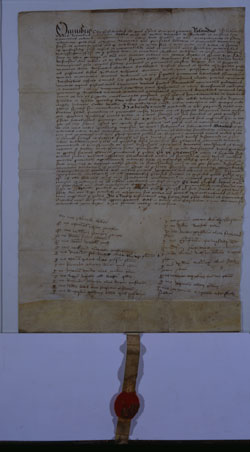|
You are here:
Sources
(1/3)
A wide range of sources survives for the history
of Rievaulx. The twelfth century is particularly well documented
and, although there is no surviving chronicle, Walter
Daniel’s
Life of Aelred (the third abbot of Rievaulx) offers a rich insight
to monastic life during the abbey’s hey-day. Walter tells
us about the administration of the abbey and the building work
that was undertaken, but he also conveys a sense of the joys and
hardships experienced by those who were members of the community
in the twelfth century.
The small parchment cartulary of Rievaulx comprises 193 folios
and dates from the late twelfth century.(1) This
is a relatively early compilation. Most of the charters are undated
and arranged
by family
and not according to the location of the grant, as was most often
the case. This unusual arrangement suggests that the Rievaulx community
was primarily concerned with the links between its benefactors.(2) The
cartulary includes copies of charters, letters of protection and
privileges. It also contains a chronological list of the abbey’s
benefactors from 1132-1188, the ‘Memorial of Benefactors’,
which shows the development of the community’s land-holdings
during the twelfth century and is integral to any analysis of the
abbey’s economy at this time.(3)
Other
surviving documents include the surrender deed of the abbey (above), which
was signed by the community
in 1538 and marked the end of monastic life in the valley of the
Rye.
<back> <next> |







